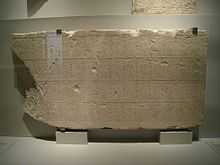Sharek
| Sharek | |||||||||||||||||||||
|---|---|---|---|---|---|---|---|---|---|---|---|---|---|---|---|---|---|---|---|---|---|
| Shalek | |||||||||||||||||||||
 The genealogy of Ankhefensekhmet (Berlin 23673) is the sole attestation for Sharek | |||||||||||||||||||||
| Pharaoh | |||||||||||||||||||||
| Predecessor | unknown | ||||||||||||||||||||
| Successor | unknown | ||||||||||||||||||||
| |||||||||||||||||||||
Sharek or Shalek could have been a poorly known ancient Egyptian pharaoh during the Second Intermediate Period of Egypt.
He was – and still is – sometimes identified with the Manethonian Salitis, the traditional founder of the 15th Dynasty who took over Lower Egypt at the beginning of the Hyksos invasion.[1][2]
Attestations
He is only attested on a non-contemporary document, a genealogy of a priest named Ankhefensekhmet who lived at the end of the 21st Dynasty – thus several centuries after Sharek's supposed reign; perhaps for this reason, Danish Egyptologist Kim Ryholt doubts his existence.[3] On the document, Sharek is placed one generation before the well-known Hyksos pharaoh Apepi of the 15th Dynasty.[1] The genealogy of Ankhefensekhmet is now exhibited at the Neues Museum in Berlin (inv. no. 23673).
References
- ↑ 1.0 1.1 Hayes, William C. (1973). "Egypt: from the death of Ammenemes III to Seqenenre II". In Edwards, I.E.S. The Cambridge Ancient History (3rd ed.), vol. II, part 1. Cambridge University Press. pp. 42–76. ISBN 0 521 082307., p. 59
- ↑ Grimal, Nicolas (1992). A History of Ancient Egypt. Oxford: Blackwell Books. ISBN 9780631174721., p. 185
- ↑ Ryholt, K.S.B. (1997). The Political Situation in Egypt during the Second Intermediate Period, c.1800–1550 BC. Copenhagen: Museum Tusculanum Press: Carsten Niebuhr Institute Publications, vol. 20., p. 402